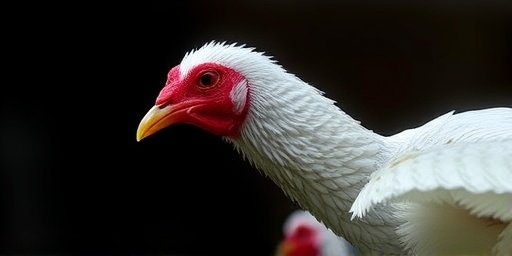In a shocking development for public health, a man from outside Seattle, Washington, has succumbed to complications from the H5N5 bird flu, marking the first human case of this strain ever recorded in the United States. The 52-year-old resident passed away on October 15, 2024, after experiencing severe respiratory distress and multi-organ failure following confirmed infection with the highly pathogenic avian influenza virus.
Health officials from the Washington State Department of Health (DOH) and the Centers for Disease Control and Prevention (CDC) confirmed the diagnosis late last week, prompting an urgent investigation into potential exposure sources and contacts. This incident arrives amid ongoing concerns over avian influenza outbreaks in poultry and wild birds across the Pacific Northwest, heightening fears of spillover to humans.
Local Poultry Worker Linked to H5N5 Outbreak Site
The victim, identified only as a longtime employee at a commercial poultry farm in King County, Washington, reportedly fell ill on October 5 after handling infected birds. According to preliminary reports, the farm had detected unusual mortality rates in its flock weeks earlier, though initial tests identified H5N1 rather than H5N5. “This man’s exposure likely occurred during routine culling and biosecurity operations,” stated Dr. Sarah Kline, epidemiologist with the Washington DOH, in a press briefing.
Symptoms began mildly—fever, cough, and fatigue—before rapidly escalating to pneumonia and acute respiratory distress syndrome (ARDS). He was hospitalized at Harborview Medical Center in Seattle, where despite aggressive antiviral treatment with oseltamivir (Tamiflu) and supportive care, his condition deteriorated. Autopsy results conclusively linked his death to H5N5 bird flu, with viral sequencing revealing a novel reassortant strain combining genes from Eurasian and North American lineages.
Colleagues at the farm, numbering around 45, are now under quarantine and prophylactic medication. As of Monday, none have shown symptoms, but nasal swabs are being monitored daily. The facility has been depopulated, with over 100,000 birds culled to contain spread.
H5N5 Strain Emerges: Deadlier Than Previous Bird Flu Variants?
The H5N5 subtype represents a rare but ominous evolution in avian influenza viruses. Unlike the more commonly tracked H5N1, which has caused sporadic human cases globally since 1997, H5N5 has primarily circulated in wild birds in Asia and Europe. Its debut in the U.S. underscores the virus’s ability to hop continents via migratory pathways, particularly along the Pacific Flyway.
Virologists note that H5N5 bird flu exhibits high pathogenicity in birds, with mortality rates exceeding 90% in infected flocks. In humans, limited data from prior cases in China (five reported since 2021, one fatal) suggest a case fatality rate around 20%. “The mutations in this strain enhance its binding to human respiratory cells, potentially increasing transmissibility,” warned Dr. Michael Osterholm, director of the Center for Infectious Disease Research and Policy (CIDRAP) at the University of Minnesota.
Genomic analysis by the CDC’s influenza division revealed that the Washington H5N5 isolate shares 98% similarity with a strain found in British Columbia wild ducks last spring. This cross-border jump highlights vulnerabilities in North American wildlife surveillance.
- Key H5N5 Traits: High avian lethality, mammalian adaptation potential, resistance to some older antivirals.
- Comparison to H5N1: H5N1 has infected 66 U.S. humans since 2024 (mostly mild dairy workers); H5N5 appears more aggressive.
- Global Toll: Over 880 human H5N1 deaths worldwide since 2003; H5N5 data sparse but concerning.
Swift Public Health Mobilization in Washington State
Washington Governor Jay Inslee declared a state of emergency for avian influenza on Sunday, allocating $5 million for expanded testing and contact tracing. The DOH has screened over 200 individuals linked to the farm, local markets, and wastewater sites, with no secondary cases detected yet.
“This first human case of H5N5 in the U.S. demands vigilance, not panic,” Inslee said during a virtual town hall. “We’re scaling up surveillance in poultry, dairy, and wild birds statewide.” The CDC has deployed a 12-person team to Seattle, activating its Influenza A(H5) response plan.
Federal agencies are ramping up production of H5N1 vaccines stockpiled since 2007, now being evaluated for cross-protection against H5N5. The USDA reports 1.2 million birds affected by avian flu in Washington this year alone, costing $500 million in losses.
Community outreach includes multilingual alerts in English, Spanish, Vietnamese, and Chinese, targeting farmworkers who face elevated risks. Hotline numbers (1-800-525-0127) are fielding hundreds of calls daily.
Experts Assess Broader Risks and Global Parallels
As news of the Washington bird flu death spreads, infectious disease specialists are drawing parallels to past pandemics. “Poultry workers are the canaries in the coal mine for zoonotic threats,” noted Dr. Angela Rasmussen, a virologist at the University of Washington’s Vaccine and Infectious Disease Division. She emphasized that while human-to-human transmission remains undetected, sustained mammal infections could spark evolution toward pandemic potential.
Internationally, H5N5 has surfaced in Nigeria (2021, poultry), Japan (2023, outbreaks), and the UK (2024, gulls). The WHO classifies it as a “highly pathogenic” virus under constant monitoring. In the U.S., this follows H5N1’s jump to dairy cows in 12 states, infecting 46 humans with mild conjunctivitis.
Economically, public health measures could strain Washington’s $2 billion poultry industry. Retail egg prices have spiked 15% locally, prompting rationing at stores like Safeway and Trader Joe’s.
“We must invest in One Health approaches—linking animal, human, and environmental surveillance—to stay ahead of these viruses.” — Dr. Peter Daszak, EcoHealth Alliance President
Prevention Strategies and Future Surveillance Outlook
For Washington residents and beyond, officials stress practical steps to mitigate H5N5 bird flu risks:
- Avoid Contact: Stay away from sick or dead birds; report sightings to authorities.
- Hygiene Protocols: Wash hands thoroughly after outdoor activities; cook poultry to 165°F.
- High-Risk Groups: Farmworkers should use PPE—masks, goggles, coveralls.
- Vaccination Push: Flu shots recommended; experimental bird flu vaccines in trials.
Looking ahead, the CDC plans nationwide genomic sequencing of avian samples, partnering with the USDA’s National Veterinary Services Laboratories. Long-term, experts call for $1 billion in funding for rapid-response infrastructure, echoing lessons from COVID-19.
While the immediate public health threat appears contained, this first human case in Washington serves as a stark reminder of nature’s unpredictability. Enhanced border testing for migratory birds and international collaboration will be key to preventing escalation. As winter migration ramps up, all eyes are on the skies—and the labs racing to decode H5N5’s next move.









